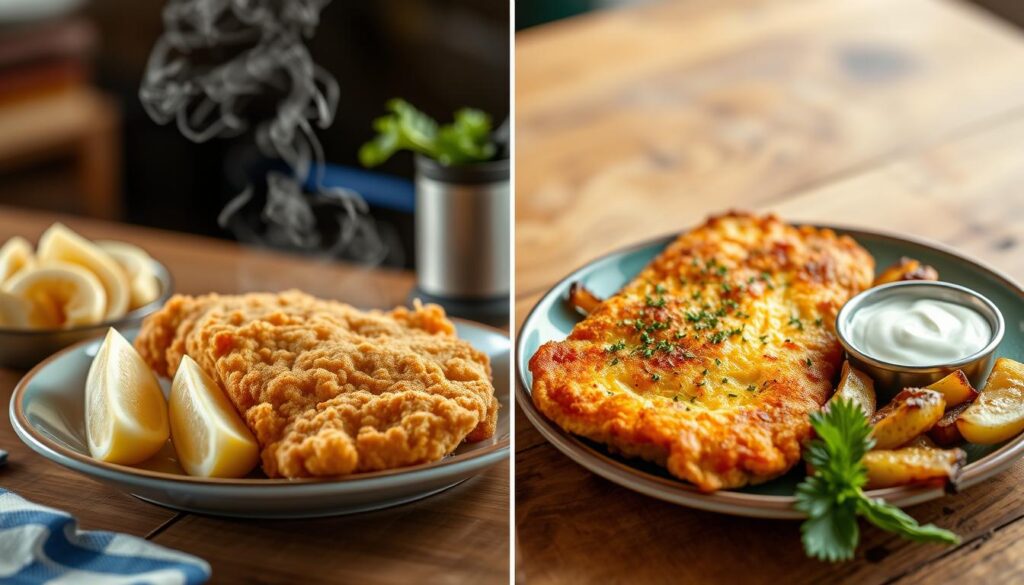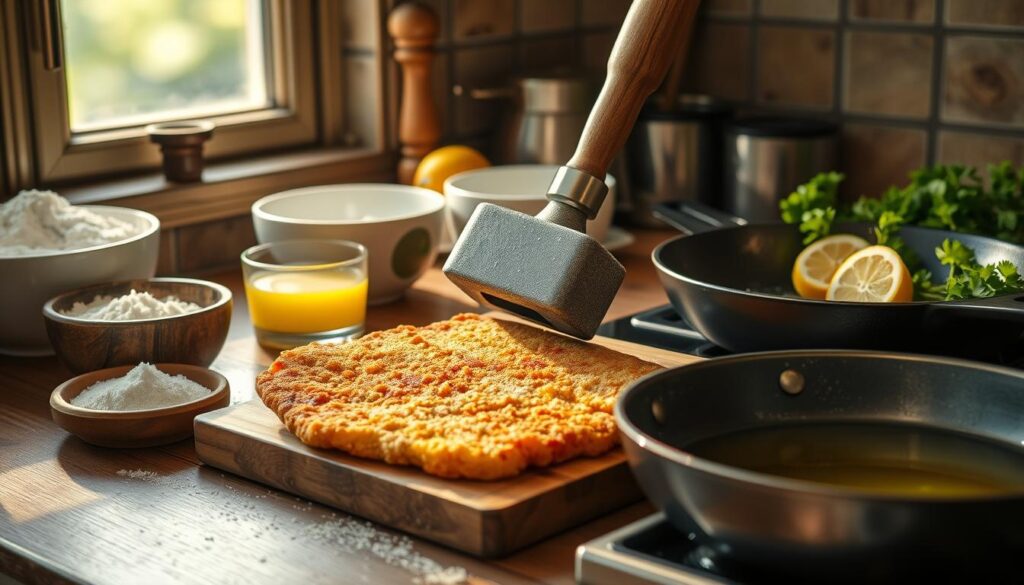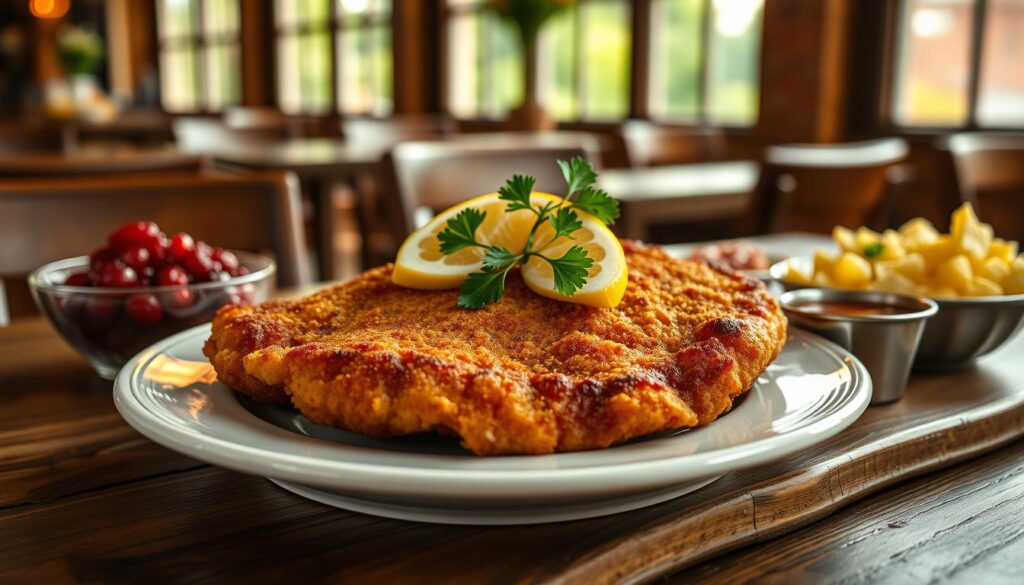Have you ever wondered why Wiener Schnitzel is so important in Austrian culture? This dish, with its thin veal and crispy coat, shows the beauty of Austrian food. It’s not just a meal; it’s a symbol of national pride.
The recipe for Wiener Schnitzel is strict. Only veal can be used. This guide will take you through its origins, ingredients, and secrets. You’ll also learn about exciting variations to try at home.
Key Takeaways
- Wiener Schnitzel is protected by Austrian law, requiring the use of veal.
- Essential ingredients include veal, flour, eggs, and breadcrumbs for authentic preparation.
- Proper cooking techniques ensure a crispy and juicy schnitzel.
- It’s best served immediately to maintain its crispiness.
- Variations of schnitzel exist, including Jägerschnitzel and others.
- Classic sides like potatoes and salads enhance the dining experience.
What is Wiener Schnitzel?
Wiener Schnitzel is a beloved dish in Austrian culture. It’s made from thin veal slices, pounded to tenderness, then breaded and fried. This makes it crispy and delicious. It’s special because of its origins and unique preparation.
Definition and Origin
The name “Wiener Schnitzel” means “Viennese cutlet” in German. It started in the 19th century in Vienna. By the 1830s, it became popular in Austria and beyond.
To be called wiener schnitzel, it must be made with veal. In Austria, only veal can be called this. Other meats, like pork or chicken, have their own names.
Legal Protection of the Dish
Austrian law protects wiener schnitzel’s authenticity. It says only veal can be used. This rule keeps the dish true to its tradition.
This law also shows the importance of Austrian cuisine. It highlights the pride in dishes like wiener schnitzel.
Ingredients for Traditional Wiener Schnitzel

Making the perfect Wiener Schnitzel starts with the right ingredients. This dish is a true taste of Austrian cuisine. Knowing what goes into it can make your cooking even better. Let’s explore the key ingredients that make a great schnitzel.
Essential Components
The ingredients for Wiener Schnitzel are simple yet crucial for its authentic flavor. You’ll need:
- Veal cutlets
- All-purpose flour
- Eggs
- Fine breadcrumbs
- Salt and pepper
This mix creates a crispy, tasty outside while keeping the meat tender. Make sure to pound the veal thin for the best texture.
Quality Matters
The quality of each ingredient greatly affects the taste of Wiener Schnitzel. Fresh veal is essential for flavor and texture. Choose high-quality breadcrumbs for a great crust. Fine breadcrumbs ensure an even coat, and free-range eggs add richness.
Using top-notch ingredients makes your schnitzel truly exceptional.
Optional Ingredient Variations
While veal is traditional, you can also try other options:
- Schweine-Schnitzel (pork cutlet)
- Puten-Schnitzel (turkey breast)
- Hänchen-Schnitzel (chicken breast)
For a unique twist, add lemon zest to the breadcrumbs. Serve your schnitzel with classic sides like potato salad or cucumber salad for a complete meal.
| Ingredient | Type | Notes |
|---|---|---|
| Veal Cutlets | Main | Should be pounded thin for optimal tenderness |
| All-Purpose Flour | Coating | Used to dust the meat before egg wash |
| Eggs | Binding | Essential for allowing breadcrumbs to adhere |
| Fine Breadcrumbs | Coating | Choose high-quality for best crispiness |
| Salt and Pepper | Seasoning | Adjust to taste for maximum flavor |
Austria: Guide to Wiener Schnitzel (fried and baked veal) guide

Choosing between fried and baked wiener schnitzel depends on what you like and your diet. Fried wiener schnitzel is the traditional choice. It’s cooked in hot oil or lard, giving it a crispy outside that’s irresistible.
To get this crispiness right, it’s key to keep the oil temperature just right. If you overcrowd the pan, the schnitzel might not cook evenly. This can make the breadcrumbs soggy.
Baked wiener schnitzel, on the other hand, is a healthier option without losing flavor. It might not be as crunchy as fried, but baking lets you add more seasonings and spices. The choice between fried and baked schnitzel shows different cooking styles and health views.
Fried vs. Baked Preparation
| Aspect | Fried Wiener Schnitzel | Baked Wiener Schnitzel |
|---|---|---|
| Cooking Method | Pan-fried in oil or lard | Baked in the oven |
| Texture | Crispy, light exterior | Less crispy but flavorful |
| Health Considerations | Higher fat content | Lower fat, healthier option |
| Preparation Time | Quick, but requires attention | Room for multitasking during baking |
Whether you choose fried or baked wiener schnitzel, both are sure to please. You might discover your favorite by trying both. This way, you can enjoy meals that fit your taste and diet perfectly.
How to Prepare Wiener Schnitzel

Making Wiener Schnitzel at home is a treat. It’s not just about the taste. It’s about the care in making it. Follow this guide to impress your guests.
Step-by-Step Instructions
Start with top-quality veal cutlets, about 130 to 200 grams each. You’ll need:
- 4 tablespoons of flour
- 2 eggs mixed with 5 tablespoons of breadcrumbs
- A splash of milk and a pinch of salt
Here’s what to do:
- First, tenderize the veal cutlets to about 4 to 6 millimeters thick.
- Use three plates: flour, egg and breadcrumb mix, and for the coated schnitzel.
- Coat each cutlet in flour, then shake off the extra.
- Dip the floured cutlet into the egg and breadcrumb mix, making sure it’s fully coated.
- Let the schnitzel sit for a few minutes before frying.
Fry the schnitzels in hot oil (around 350°F) for 3 minutes on each side. They should be golden brown. Drain them on paper towels for that crispy texture.
Tips for Perfect Breading
Here are some tips for crispy schnitzel:
- Don’t overcrowd the pan to keep the oil temperature up.
- Fry in small batches for even cooking.
- Make sure the oil is hot before adding the schnitzel to avoid sogginess.
- Let the fried schnitzels rest briefly on paper towels to absorb excess oil.
By following this guide, you’ll learn how to make delicious Wiener Schnitzel. Enjoy your cooking journey and the amazing flavors of this traditional dish!
Common Mistakes to Avoid

When making Wiener Schnitzel, watch out for common mistakes. These can ruin the dish’s quality. Here are a few key mistakes to avoid.
Overcooking the Meat
One big mistake is overcooking the meat. This makes the schnitzel tough and loses its flavor. To keep it tender, cook it for 2-3 minutes on each side. This way, you avoid drying out the meat and keep it juicy.
Incorrect Oil Temperature
Getting the oil temperature right is also crucial. Too hot oil can burn the coating and undercook the meat. Too cold oil makes the schnitzel soggy. Use a thermometer to keep the oil between 350°F and 375°F. This ensures a crispy schnitzel every time.
| Mistake | Effect | Solution |
|---|---|---|
| Overcooked Meat | Dry and tough texture | Cook for 2-3 minutes per side |
| Incorrect Oil Temperature | Soggy or burnt coating | Maintain oil at 350°F to 375°F |
Traditional Serving Suggestions

Serving wiener schnitzel right can make your meal better. The sides you choose are key. They help balance the flavors and textures of this dish. A light, refreshing side is perfect with the crispy schnitzel.
Classic Sides for Wiener Schnitzel
Choosing the right sides makes the meal better. Here are some classic options:
- Potato Salad – A creamy, tangy potato salad complements the schnitzel well.
- Cucumber Salad – This fresh salad adds a nice crunch.
- French Fries – Crispy fries make a great side for schnitzel.
Using warm plates keeps everything at the right temperature. This ensures your schnitzel stays tasty.
Garnishing Techniques
Keeping garnishes simple is best for wiener schnitzel. Here are a few ideas:
- Add a wedge of fresh lemon – It adds a nice acidity and brightens the dish.
- Sprinkle fresh parsley – It looks good and adds a bit of flavor.
These garnishing tips can make your dish look and taste better. They let the schnitzel be the main attraction.
Best Places to Try Authentic Wiener Schnitzel in Austria

In Austria, trying Wiener Schnitzel is a must. Its rich flavors and crispy texture are best enjoyed at top spots in Vienna and beyond. Here are the top places to try this traditional dish.
Must-Visit Restaurants
For a real authentic experience, check out these restaurants known for their Wiener Schnitzel:
- Schwarzes Kameel – Boasting over 400 years of tradition.
- Meissl & Schadn at Grand Ferdinand Hotel – A classic choice.
- Meierei im Stadtpark – Perfectly located near the city’s green spaces.
- Figlmüller – A renowned name specializing in both veal and pork schnitzels.
- Gasthaus Wolf – Shares a rich history with locals.
- Plachutta’s Gasthaus zur Oper – Dedicated to preserving the essence of the original dish.
Locally Recommended Eateries
To explore local flavors, try these eateries for schnitzel that offer a home-style feel:
- Gmoakeller – Popular among Viennese residents.
- Glacis Beisl – Known for its vast wine selection paired with schnitzel.
- Gasthaus Grünauer – Offers a traditional touch in the 8th district.
- Gasthaus zu den drei Hacken – A hidden gem on Singerstraße.
- Pichlmaiers zum Herkner – Revitalized by the Pichlmaier brothers.
- Blauensteiner – Appreciated for its regional character.
Wiener Schnitzel Variations

Exploring schnitzel reveals many tasty options. You can try different types, each with its own flavor and look. The classic Wiener schnitzel is just the start. Many variations have been created, each appealing to different tastes.
Exploring Different Types of Schnitzels
Looking into wiener schnitzel variations, you’ll find many tasty choices. Here are some favorites:
- Jägerschnitzel: Cutlets topped with a rich mushroom gravy.
- Käseschnitzel: A cheesy treat with gooey cheese on top.
- Münchner Schnitzel: Coated with horseradish or mustard before breading.
- Naturschnitzel: Served plain, often with a simple pan sauce.
- Paprikaschnitzel: Drenched in a tangy tomato sauce with paprika.
- Rahmschnitzel: Covered in a creamy sauce, often with mushrooms.
- Schnitzel Holstein: Topped with onions, capers, and a fried egg.
- Vegetarisches Schnitzel: A meatless option made from soy or tofu.
- Balkanschnitzel: Features a vibrant sauce with tomatoes and bell peppers.
- Traditional Wiener Schnitzel: Made with veal.
Jägerschnitzel and Other Variations
The jägerschnitzel recipe is a favorite. It’s loved for its creamy mushroom sauce. Other tasty options include pork and chicken schnitzels. Each type offers a unique culinary journey.
Conclusion
This authentic wiener schnitzel guide shows us why this Austrian dish is loved by many. It started in the 19th century, influenced by French cooking. Now, it’s a favorite around the world, with options for everyone.
Creating a great wiener schnitzel takes care and skill. You need the right ingredients and know how to fry them well. Using the best cookware, like carbon steel pans, makes each cutlet crispy and golden.
Side dishes like lingonberry jam and spaetzle add to the joy of eating it. So, whether you’re eating out or making it at home, wiener schnitzel is more than food. It’s a way to connect with Austrian culture and enjoy good times with great food.

